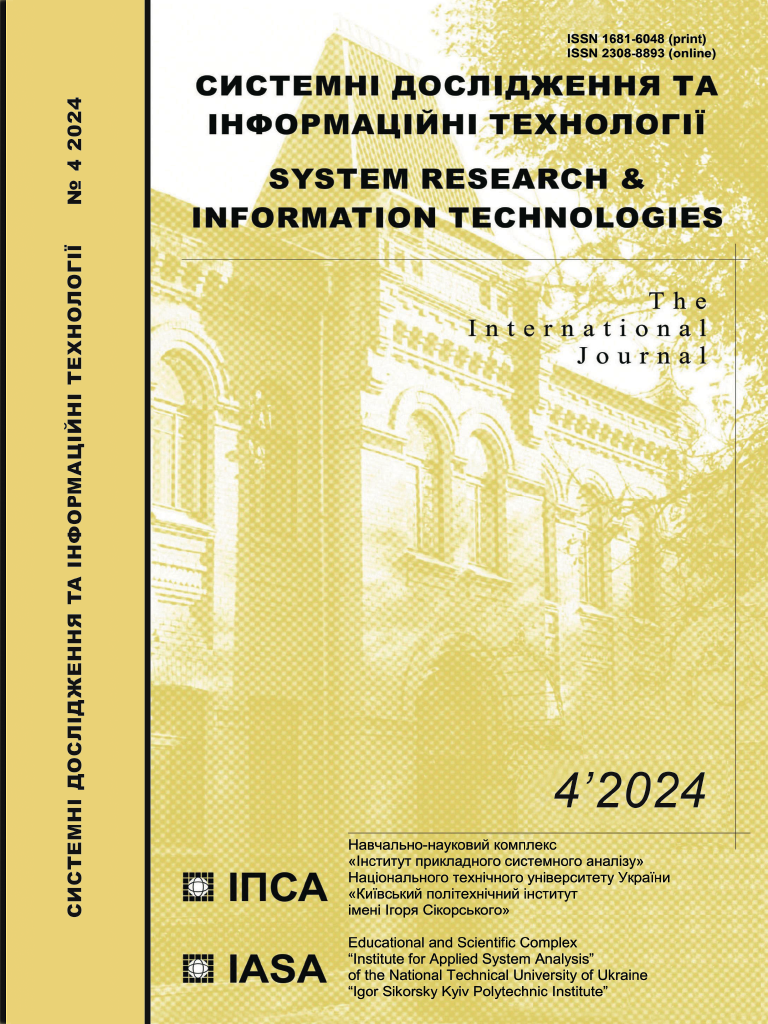Crowd navigation monitoring during emergencies
DOI:
https://doi.org/10.20535/SRIT.2308-8893.2024.4.03Keywords:
computer vision, object tracking, object speed, video surveillanceAbstract
The paper considers the task of crowd navigation monitoring, which might be performed using various sensors and technologies, with surveillance cameras being the most commonly employed. These cameras provide a video stream that typically lacks supplementary information. Extracting additional data from these streams could significantly enhance pedestrian behavior modeling and the automation of the monitoring process. A critical parameter in the analysis of pedestrian movement is their speed. The analytical method and the algorithm of pedestrians’ speed estimation based on the surveillance camera video are proposed. The first step of the proposed algorithm is object detection and tracking between frames. The second step is the speed estimation method, which is based on calculating the real-world distances and knowing camera parameters and distances in pixels on the resulting image. Implementation of the algorithm was tested on real videos and showed an error of about 0.04 m/s.
References
S.W. Ibrahim, “A comprehensive review on intelligent surveillance systems,” CST, vol. 1, no. 1, pp 7–14, May 2016.
O.V. Aharkov, “Object detection and tracking by motion analysis,” Shtuchnyi intelekt, no. 1-2, pp. 28–35, 2015.
O.V. Bahatskyi, “The instrumental complex for research algorithms for object boundaries,” Computers means, networks and systems, no. 15, pp. 74–78, 2016.
P. Bischoff, Surveillance camera statistics: which cities have the most CCTV cameras? Accessed on: May 23, 2023. [Online]. Available: https://www.comparitech.com/vpn-privacy/the-worlds-most-surveilled-cities/
A. Moody, “Speed Camera Hotspots,” GoShorty. Accessed on: Jan 17, 2022. [Online]. Available: https://goshorty.co.uk/blog/speed-camera-hotspots/
R.D. Sharma, S.K. Gupta, “A Survey on Moving Object Detection and Tracking Based On Background Subtraction,” Oxford Journal of Intelligent Decision and Data Science, vol. 2018, pp. 55–62, 2018. doi: https://doi.org/10.5899/2018/ojids-00041
P. Spagnolo, T. Orazio, M. Leo, and A. Distante, “Moving object segmentation by background subtraction and temporal analysis,” Image and Vision Computing, vol. 24, no. 5, pp. 411–423, 2006. doi: https://doi.org/10.1016/j.imavis.2006.01.001
A. Hardas, B.M. Dattatray, and M. Vibha, “Moving Object Detection using Background Subtraction Shadow Removal and Post Processing,” International Journal of Computer Applications, ICCT 2015, pp. 1–5, 2015.
P. Kalaivani, S. Vimala, “Human action recognition using background subtraction method,” International Research Journal of Engineering and Technology, vol. 2, pp. 1032–1035, 2015.
M.A. Shvandt, V.V. Moroz, “Overview of the detection and tracking methods of the lab animals,” System Research and Information Technologies, no. 1, pp. 124–148, Apr 2022. doi: https://doi.org/10.20535/SRIT.2308-8893.2022.1.10
D. Khan, “Estimating Speeds and Directions of Pedestrians in Real-Time Videos: A solution to Road-Safety Problem” in AgeingAI 2013 The Challenge of Ageing Society: Technological Roles and Opportunities for Artificial Intelligence, Turin, Italy, 2013.
F. Zhao, J. Li, “Pedestrian Motion Tracking and Crowd Abnormal Behavior Detection Based on Intelligent Video Surveillance,” Journal of Networks, no. 10, pp. 2598–2605, 2014. doi: https://doi.org/10.4304/jnw.9.10.2598-2605
B.Y. Wang, A. Bochkovskiy, and H.Y.M. Liao, “YOLOv7: Trainable bag-of-freebies sets new state-of-the-art for real-time object detectors,” in CVPR, New Orleans, LA, USA, 2022, pp. 7464–7475. doi: https://doi.org/10.48550/arXiv.2207.02696
K. Teknomo, “Microscopic Pedestrian Flow Characteristics: Development of an Image Processing Data Collection and Simulation Model,” Ph.D. dissertation, Department of Human Social Information Sciences, Graduate School of Information Sciences, Tohoku University, Japan, 2002.
A. Tordeux, M. Chraibi, A. Seyfried, and A. Schadschneider, “Prediction of Pedestrian Speed with Artificial Neural Networks,” in Proc. Int. Conf. Traffic Granular Flow, pp. 327–335, 2017. doi: https://doi.org/10.1007/978-3-030-11440-4_36
G. Guo et al., “A Pose Awareness Solution for Estimating Pedestrian Walking Speed,” Remote Sensing, vol. 11, no. 1, pp. 55–73, 2019. doi: https://doi.org/10.3390/rs11010055
B. Huang, G. Mao, Y. Qin, and Y. Wei, “Pedestrian flow estimation through passive WiFi sensing,” IEEE Trans. on Mobile Computing, vol. 20, no. 4, pp. 1529–1542, 2021. doi: https://doi.org/10.1109/TMC.2019.2959610
G.G. Lee, K.H. Ka, and W.Y. Kim, “Estimation of pedestrian flow speed in surveillance videos,” in Conf. Korean Society of Broadcast Engineers Conference, Seoul, Republic of Korea, 2009, pp. 330–333.
R. Munawar, YOLOv7 object tracking. 2023. [Online]. Available: https://github.com/RizwanMunawar/yolov7-object-tracking
M. Tishkov, Pedestrian speed estimation. 2024. [Online]. Available: https://github.com/MaksymTishkov/pedestrian_speed_estimation

